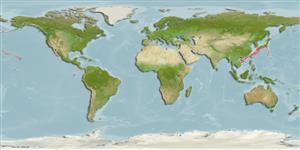Élasmobranches (requins et raies) (sharks and rays) >
Squaliformes (Sleeper and dogfish sharks) >
Etmopteridae (Lantern sharks)
Etymology: Trigonognathus: Greek, trigono = a triangle + Greek, gnathos = jaw (Ref. 45335). Refers to the triangular shape of the jaws (Ref. 31259); kabeyai: Named after Mr. Hiromichi Kabeya who collected the type specimens (Ref. 31259).
Environment: milieu / climate zone / depth range / distribution range
Écologie
marin bathydémersal; profondeur 330 - 360 m (Ref. 31259). Deep-water
Northwest Pacific: Wakayama and Tokushima, Japan (Ref. 31259). Reported from the Hawaiian Islands (Ref. 58302).
Length at first maturity / Taille / Poids / Âge
Maturity: Lm 52.0 range ? - ? cm
Max length : 47.0 cm TL mâle / non sexé; (Ref. 55729); 53.9 cm TL (female); poids max. publié: 425.60 g (Ref. 55729); poids max. publié: 425.60 g
Specimens collected between 330 and 360 m (Ref. 31259). Ovoviviparous (Ref. 205).
Life cycle and mating behavior
Maturité | Reproduction | Frai | Œufs | Fécondité | Larves
Distinct pairing with embrace (Ref. 205).
Mochizuki, K. and F. Ohe, 1990. Trigonognathus kabeyai, a new genus and species of the squalid sharks from Japan. Jap. J. Ichthyol. 36(4):385-390. (Ref. 31259)
Statut dans la liste rouge de l'IUCN (Ref. 130435)
Menace pour l'homme
Harmless
Utilisations par l'homme
Plus d'informations
Taille/ÂgeCroissanceLongueur-poidsLongueur-longueurFréquences de longueursMorphométrieMorphologieLarvesDynamique des populations larvairesRecrutementAbondanceBRUVS
RéférencesAquacultureProfil d'aquacultureSouchesGénétiqueElectrophoresesHéritabilitéPathologiesTraitementNutrientsMass conversion
CollaborateursImagesStamps, Coins Misc.SonsCiguateraVitesseType de nageSurface branchialeOtolithesCerveauxVision
Outils
Articles particuliers
Télécharger en XML
Sources Internet
Estimates based on models
Preferred temperature (Ref.
123201): 10.4 - 16.3, mean 11.4 °C (based on 5 cells).
Phylogenetic diversity index (Ref.
82804): PD
50 = 1.0000 [Uniqueness, from 0.5 = low to 2.0 = high].
Bayesian length-weight: a=0.00372 (0.00188 - 0.00734), b=3.10 (2.92 - 3.28), in cm total length, based on LWR estimates for this (Sub)family-body shape (Ref.
93245).
Niveau trophique (Ref.
69278): 4.5 ±0.4 se; based on diet studies.
Résilience (Ref.
120179): Faible, temps minimum de doublement de population : 4,5 à 14 années (Fec assumed to be <100).
Fishing Vulnerability (Ref.
59153): Moderate vulnerability (42 of 100).
